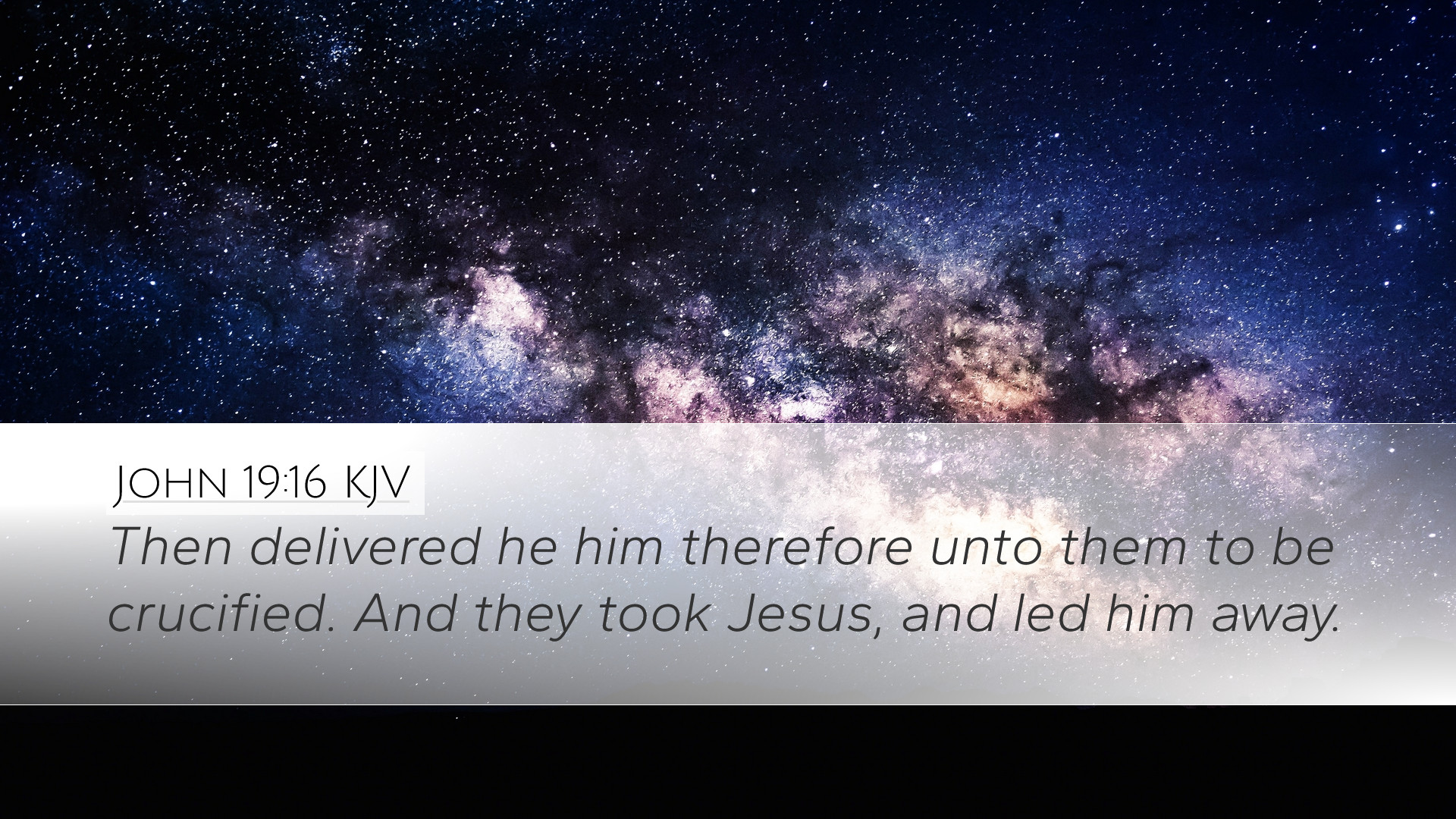Commentary on John 19:16
Verse: "Then delivered he him therefore unto them to be crucified. And they took Jesus, and led him away." (John 19:16)
Introduction
This verse marks a pivotal moment in the Christian narrative—Jesus' transition from trial to crucifixion. It encapsulates the culmination of a series of events that reveal the rejection of Christ by both the Jewish leaders and the Romans. This commentary seeks to unpack the theological and historical significance of this moment using insights from classical public domain commentaries.
The Context of the Crucifixion
Throughout John's Gospel, the theme of Jesus as the sacrificial Lamb is prevalent. Matthew Henry notes the importance of understanding the context surrounding Jesus' trial and subsequent sentencing. The Jewish leaders, feeling threatened by Jesus' influence and teachings, conspired to ensure His death—a fulfillment of their own prophecies and an act that highlights human depravity.
The Role of Pilate
Albert Barnes emphasizes the ambivalence of Pontius Pilate, who, despite finding no guilt in Jesus (John 18:38), ultimately capitulates to public pressure. Pilate's actions reflect a moral weakness, enabling injustice while attempting to wash his hands of responsibility. This moment illustrates the broader theme of political expediency versus moral conviction.
The Jewish Leaders' Influence
Adam Clarke points out that the Jewish leaders had significant sway over the populace, manipulating public sentiment to achieve their ends. Their call for crucifixion, as opposed to a lesser punishment, was indicative of their desire to see Jesus not merely punished but humiliated and discredited publicly. This ridicule served to solidify their own power and negate the claims of Jesus' messiahship.
Theological Implications
The act of delivering Jesus to be crucified holds profound theological implications. It resonates with the concept of atonement, where Jesus is seen as the Lamb of God who takes away the sins of the world (John 1:29). Matthew Henry reflects on this sacrificial role of Christ, noting that His passion was not merely a tragedy but a divine necessity—for through His suffering, salvation would be made available to humanity.
Prophetic Fulfillment
Furthermore, the events surrounding the crucifixion fulfill Old Testament prophecies concerning the suffering servant (Isaiah 53). Barnes highlights that Jesus’ delivery to death was not a surprise to Him; rather, it was foretold and part of the redemptive plan. This aspect is crucial for understanding the sovereignty of God in the events of the crucifixion.
Symbolism of the Crucifixion
The crucifixion itself becomes a multi-faceted symbol within Christian theology. Adam Clarke elaborates on the spiritual significance of the cross, which represents both the depth of human sin and the heights of divine love. It is through Jesus’ death that believers find life, as His sacrifice reconciles mankind to God.
Application for Believers
The profound nature of Jesus' sacrifice calls for reflection among believers. Matthew Henry encourages Christians to recognize the weight of their sins that necessitated such a sacrifice. It reminds us of the serious cost of sin and invites a response of gratitude, confession, and commitment to live in accordance with Christ's teachings.
The Response of the Disciples
The response of Jesus’ disciples during this moment of trial is worth noting. Initially, they are depicted as confused and fearful, unsure of where their Master’s path will ultimately lead. Barnes points out that this illustrates a broader theme of human doubt in the face of divine providence. Yet, in retrospect, these moments serve to strengthen the resolve of the early church post-resurrection.
Conclusion
John 19:16 serves as a reminder of the complexity surrounding the events leading to the crucifixion of Christ. It encapsulates the intertwining of human action and divine purpose. The reflections provided by Matthew Henry, Albert Barnes, and Adam Clarke enhance our understanding of this moment in Scripture. As pastors, students, theologians, and scholars, it is incumbent upon us to glean from these insights and appreciate the depth of Christ's sacrifice offered on the cross.
References for Further Study
- Matthew Henry's Commentary on the Whole Bible
- Albert Barnes' Notes on the New Testament
- Adam Clarke's Commentary on the Holy Bible


